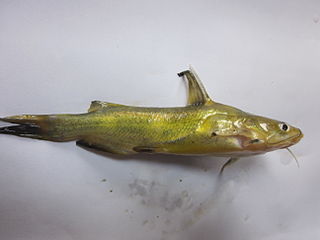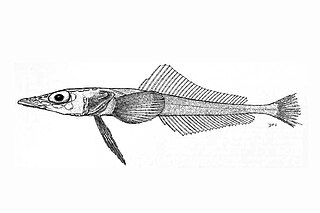
Nanochromis is a genus of small cichlids endemic to the Congo River Basin in Central Africa.

Pelteobagrus is a genus of bagrid catfishes found in eastern Asia. The taxonomy of this genus is unclear and many authorities treat it as a junior synonym of Tachysurus and the type species of the genus, is Silurus calvarius which is a synonym of Tachysurus fulvidraco.

The bare-crowned antbird is a species of bird in the family Thamnophilidae in the monotypic genus Gymnocichla.
Euristhmus is a genus of eeltail catfishes native to the eastern Indian-western Pacific Oceans around Australia, New Guinea and Indonesia.

Ogilbia is a genus of viviparous brotulas. The generic name honours the Australian naturalist James Douglas Ogilby (1853-1925), for his contribution to the knowledge of the fishes of Australia.

Neoclinus is a genus of chaenopsid blennies found in the North Pacific ocean along the coasts of California, Baja California, Japan, Korea and Taiwan.

Tachysurus is a genus of bagrid catfishes found in eastern Asia and as a fossil in Africa. The currently recognized species in this genus are:

Akarotaxis is a monotypic genus of marine ray-finned fish belonging to the family Bathydraconidae, the Antarctic dragonfish, its only species is Akarotaxis nudiceps. They are found in the Southern Ocean along the continental shelf of Antarctica.

Caffrogobius is a genus of gobies native to the Atlantic and Indian Ocean coasts of southern Africa and from around the Seychelles.

Saperdini is a tribe of longhorn beetles of the subfamily Lamiinae.

Glenida is a genus of longhorn beetles of the subfamily Lamiinae.
Glenida cyaneipennis is a species of beetle in the family Cerambycidae. It was described by Charles Joseph Gahan in 1888. It is known from Taiwan and China.
Glenida cyaneofasciata is a species of beetle in the family Cerambycidae. It was described by Stephan von Breuning in 1952. It is known from Bhutan.

Glenida puncticollis is a species of beetle in the family Cerambycidae. It was described by Stephan von Breuning in 1961. It is known from Vietnam.
Glenida suffusa is a species of beetle in the family Cerambycidae. It was described by Charles Joseph Gahan in 1888. It is known from China.
Cyperus nudiceps is a species of flowering plant in the family Cyperaceae, only found on Cocos Island. It was first described as Kyllinga nudiceps in 1929 and transferred to Cyperus in 1944.
Canuleius is a genus of walkingsticks in the family Heteronemiidae. There are at least 20 described species in Canuleius.
Neoclinus nudiceps is a species of chaenopsid blenny found around Japan in the north-west Pacific Ocean where it is inhabits cavities within rocky areas.
Ancistrus nudiceps is a species of catfish in the family Loricariidae. It is native to South America, where it occurs in the Takutu River basin in the upper Branco River drainage in Guyana, and the Cuyuni River in Venezuela. The species reaches 7.9 cm (3.1 in) SL.









